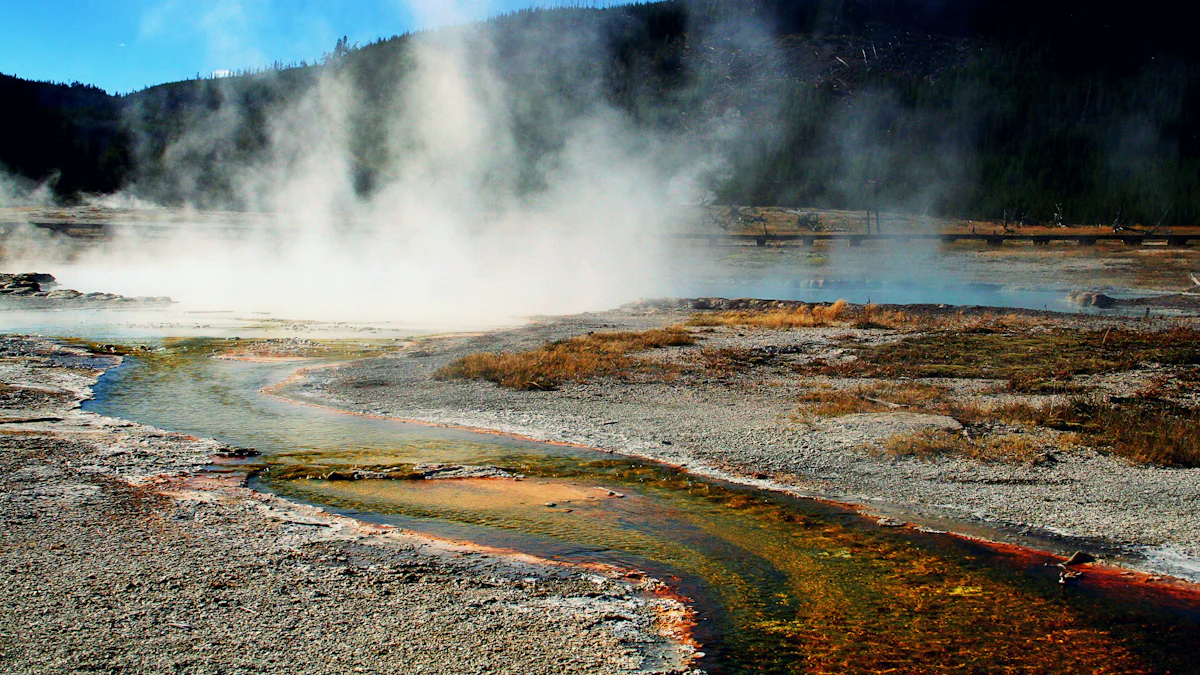The steel industry faces a massive challenge: reducing its carbon footprint while meeting global demand. Steel production contributes 11% of global CO2 emissions, with blast furnace-basic oxygen furnace (BF-BOF) methods responsible for 86% of these emissions. You might wonder how this can change. Hydrogen technology offers a solution. By replacing carbon-intensive processes, it could transform steel decarbonization. Thyssenkrupp has led this effort, but Baosteel’s innovative strategies aim to surpass them. With hydrogen-based methods projected to dominate 64% of primary steel production by 2050, Baosteel’s approach could redefine the industry’s future.
Key Takeaways
- Using hydrogen can cut CO2 pollution in making steel. It is a cleaner choice than old methods.
- Baosteel plans to use 80%-90% hydrogen by 2030. This will make them a leader in green steelmaking.
- Thyssenkrupp has improved hydrogen steelmaking, cutting pollution by 20% with new ideas.
- Both companies face problems like high costs and needing green energy. But their rivalry helps create new solutions.
- Spending on hydrogen helps fight climate change and boosts steel business success.
Steel Decarbonization: Challenges and Opportunities

The Steel Industry’s Carbon Footprint
You may not realize it, but the steel industry is one of the largest contributors to global carbon emissions. It accounts for 11% of global carbon emissions and 7-9% of greenhouse gas emissions. The primary culprit is the blast furnace-basic oxygen furnace (BF-BOF) route, which produces 86% of steel emissions. Even the electric arc furnace (EAF) route, often considered cleaner, contributes 15%. Additionally, mining metallurgical coal, a key input in steelmaking, can increase the carbon footprint by up to 27%.
The industry faces significant challenges in reducing its emissions. Here’s a breakdown:
| Challenge | Description |
|---|---|
| Reliance on carbon-intensive methods | The steel industry primarily uses blast furnace production, which is highly carbon-intensive. |
| High costs of new technologies | Implementing low-carbon technologies is expensive, creating a barrier to transition. |
| Investment needs | Significant investment is required to develop and scale low-carbon alternatives. |
These challenges make steel decarbonization a complex but urgent task.
The Role of Hydrogen in Decarbonization
Hydrogen offers a promising path to reduce emissions in steel production. Unlike traditional methods, hydrogen-based steelmaking replaces carbon with hydrogen as a reducing agent, eliminating CO2 emissions. For example, the HYBRIT project in Sweden has successfully produced fossil-free steel using hydrogen-based direct reduction. This innovation could bring fossil-free steel to the market by 2026.
Other opportunities also exist for the industry to adopt greener technologies:
- Assess and adopt clean technologies.
- Increase production of sustainable steel.
- Improve ESG (Environmental, Social, and Governance) performance.
- Embrace digitization to unlock value.
- Collaborate with stakeholders to accelerate the transition.
Hydrogen, however, is not without its challenges. Producing hydrogen efficiently remains a hurdle. Electrolytic hydrogen, for instance, has a round-trip efficiency of only 24%, leading to significant energy losses. Despite these limitations, hydrogen remains a key player in the journey toward steel decarbonization.
Thyssenkrupp’s Hydrogen-Based Steelmaking
Achievements in Hydrogen Steel Production
Thyssenkrupp has made remarkable progress in hydrogen-based steelmaking. On November 11, 2019, it became the first company to inject hydrogen into a blast furnace. This milestone demonstrated the potential to reduce CO2 emissions by up to 20% using hydrogen in traditional steel production. Thyssenkrupp also launched the tkH2Steel decarbonization project, which aims to revolutionize steelmaking.
The company introduced bluemint® Steel, a product that reduces CO2 emissions by up to 70% compared to conventional steel. This innovation represents a significant step toward sustainable steel production. Thyssenkrupp plans to operate a direct reduction plant fully on hydrogen by 2029. The plant will have the capacity to produce 2.5 million metric tons of directly reduced iron annually, saving up to 3.5 million metric tons of CO2 each year.
Thyssenkrupp employs advanced technologies to achieve these goals. Water electrolysis plays a key role in producing green hydrogen, which powers their hydrogen steel production. The company is also developing a direct reduction process that uses hydrogen instead of carbon, marking a major advancement in steel decarbonization.
Limitations and Challenges
Despite its achievements, Thyssenkrupp faces significant challenges. The high cost of hydrogen production and renewable electricity makes hydrogen steelmaking less economically viable than traditional methods. The company also requires large-scale renewable electricity production to support its operations. This dependency on intermittent renewable energy adds complexity to infrastructure planning.
Economic barriers further hinder the adoption of hydrogen-based technologies. Thyssenkrupp’s direct reduction plant project, supported by two billion euros in funding, highlights the financial resources needed to transition away from natural gas. The company must overcome these hurdles to make hydrogen steelmaking a widespread reality.
Thyssenkrupp’s efforts in hydrogen steel production showcase its commitment to innovation. However, addressing these challenges will be crucial for the company to lead the global transition toward sustainable steelmaking.
Baosteel’s Hydrogen Gambit

Strategic Vision for Hydrogen Integration
Baosteel has set ambitious goals to integrate hydrogen into its steel production processes. The company aims to boost the hydrogen ratio in its direct reduced iron (DRI) plant to 80%-90% by 2030. This shift will significantly reduce carbon emissions and align with global sustainability goals. By 2027, Baosteel plans to cut its carbon emissions by 30% compared to 2020 levels. The ultimate vision is to produce carbon-free auto sheet steel by 2030.
Baosteel has already taken a major step by initiating China’s first hydrogen-based shaft furnace. This facility, which began construction in February 2022, can produce one million tons of steel annually. By integrating hydrogen and coke oven gas, it aims to reduce CO2 emissions by 500,000 tons each year.
| Target | Description |
|---|---|
| Hydrogen Ratio | Boost hydrogen ratio at DRI plant to 80%-90% by 2030 |
| Carbon Emission Reduction | Reduce carbon emissions by 30% from 2020 levels by 2027 |
| Carbon-Free Production | Achieve total carbon-free auto sheet production by 2030 |
Technological Innovations in Steel Decarbonization
Baosteel is pioneering the use of pure hydrogen as a reducing agent in its DRI plant. This innovation aims to replace carbon-intensive methods, making steel production more sustainable. The company also focuses on achieving carbon neutrality by 2050. To meet this goal, Baosteel is transforming its production processes and accelerating the development of low-carbon technologies.
In addition to steel, Baosteel is exploring high-performance materials for the automobile sector. This strategic shift positions the company as a leader in replacing traditional products with advanced alternatives. Baosteel’s collaboration with Australian universities further highlights its commitment to research and development in green technologies.
Overcoming Barriers to Adoption
Despite its progress, Baosteel faces significant challenges in scaling hydrogen-based steelmaking. Ensuring a steady supply of DR-grade iron ore is critical. Establishing a sustainable green hydrogen value chain also remains a priority. The process requires a consistent supply of renewable electricity, which adds complexity to operations.
| Key Obstacles | Description |
|---|---|
| DR-grade iron ore supply | Ensuring adequate supply for hydrogen-based steelmaking |
| Green hydrogen value chain | Building a sustainable value chain for green hydrogen |
| Renewable energy supply | Guaranteeing consistent renewable electricity for large-scale operations |
| Electrolyser capacity | Investing in gigawatt-scale electrolyser projects for hydrogen production |
Baosteel’s focus on overcoming these barriers demonstrates its commitment to advancing steel decarbonization and leading the industry toward a sustainable future.
Comparing Baosteel and Thyssenkrupp
Scalability and Efficiency
When it comes to scalability, both Baosteel and Thyssenkrupp are making strides in hydrogen steelmaking. Thyssenkrupp has already industrialized hydrogen use by injecting it into a blast furnace, reducing CO2 emissions by up to 20%. The company is also preparing its infrastructure for large-scale hydrogen use through the H2Stahl project, which aims to integrate hydrogen into existing processes by 2025. Additionally, a new pipeline will connect Thyssenkrupp’s plant to Air Liquide’s hydrogen network, ensuring a steady supply.
Baosteel, on the other hand, is focusing on scaling its hydrogen-based shaft furnace, which can produce one million tons of steel annually. By 2030, Baosteel plans to achieve an 80%-90% hydrogen ratio in its direct reduced iron (DRI) plant. This ambitious target highlights its commitment to efficiency and scalability. However, challenges like securing DR-grade iron ore and renewable energy remain critical for both companies.
Environmental Impact
You might wonder how these companies compare in terms of environmental benefits. Thyssenkrupp’s direct reduction plant, set to operate fully on hydrogen by 2029, is expected to save up to 3.5 million metric tons of CO2 annually. This aligns with its goal of reducing emissions through innovative hydrogen technologies.
Baosteel’s hydrogen gambit also promises significant environmental gains. Its hydrogen-based shaft furnace aims to cut CO2 emissions by 500,000 tons annually. By 2030, Baosteel plans to produce carbon-free auto sheet steel, further solidifying its role in sustainable steel production. Both companies are pushing boundaries, but Thyssenkrupp’s reliance on green hydrogen availability could slow its progress.
Market Position and Future Prospects
Baosteel dominates the Chinese steel market, accounting for 5% of the industry’s output and 20% of its profits. Its focus on hydrogen steelmaking and global expansion positions it as a transformative leader. Thyssenkrupp, a global leader in stainless steel flat products, is pursuing a different strategy. Its tender for hydrogen supply and €2 billion investment in a direct reduction plant reflect its commitment to innovation.
Looking ahead, both companies have promising prospects. Thyssenkrupp’s direct reduction plant will produce 2.5 million metric tons of directly reduced iron annually, while Baosteel’s hydrogen integration could redefine steelmaking in China. Their competition is driving innovation, accelerating the transition to a sustainable future.
Baosteel’s advancements in hydrogen technology position it as a leader in steel decarbonization. Its shift from traditional manufacturing to innovation and service sets a new global standard. You can see how this strategy enhances performance with sustainable practices and new materials.
- Baosteel’s commitment to reducing greenhouse gas emissions aligns with global climate goals.
- Its integration of green, low-carbon metallurgy supports worldwide climate initiatives.
This competition with Thyssenkrupp drives innovation, accelerating the steel industry’s transition. Baosteel’s success could redefine steelmaking and play a vital role in achieving climate action targets.
FAQ
1. What makes hydrogen steelmaking better for the environment?
Hydrogen steelmaking replaces carbon with hydrogen as a reducing agent. This process eliminates CO2 emissions, unlike traditional methods that release large amounts of greenhouse gases. It offers a cleaner, more sustainable way to produce steel while aligning with global climate goals.
2. Why is Baosteel focusing on hydrogen technology?
Baosteel aims to lead the steel industry’s decarbonization efforts. Hydrogen technology helps reduce emissions and supports their goal of producing carbon-free steel by 2030. This strategy aligns with global sustainability trends and strengthens their market position.
3. What challenges do companies face with hydrogen steelmaking?
Hydrogen steelmaking requires a steady supply of renewable energy and green hydrogen. Companies also face high costs for infrastructure and technology. Securing DR-grade iron ore and scaling production add further complexity to the transition.
4. How does Thyssenkrupp’s approach differ from Baosteel’s?
Thyssenkrupp focuses on integrating hydrogen into existing processes, like injecting it into blast furnaces. Baosteel prioritizes pure hydrogen use in direct reduced iron (DRI) plants. Both approaches aim to reduce emissions but differ in scalability and technological focus.
5. Can hydrogen steelmaking replace traditional methods entirely?
Hydrogen steelmaking has the potential to replace traditional methods, but challenges like cost, energy supply, and infrastructure need solutions. As technology advances and renewable energy becomes more accessible, hydrogen steelmaking could dominate the industry by 2050.
Tip: Keep an eye on advancements in hydrogen technology. It’s shaping the future of sustainable steel production!
